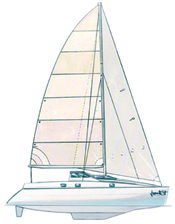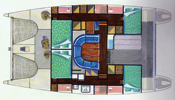Privilege 39
While no speed demon, this well-built cat makes for a capable world cruiser
 The Privilege 39 is a terrific boat for a family of six to sail around the world. It is a fine boat for knocking around the Caribbean on a sailing sabbatical. It's not a bad boat to start a charter business with either. Get the point? The Eric Le Ferve-designed Privilege 39 is a versatile and capable cruiser. And with prices for used models at or below $200,000 it is also a very good value. If you need proof, spend an afternoon carefully inspecting one of these solidly built cruising cats and then see what $200,000 buys in other cruising catamarans.
The Privilege 39 is a terrific boat for a family of six to sail around the world. It is a fine boat for knocking around the Caribbean on a sailing sabbatical. It's not a bad boat to start a charter business with either. Get the point? The Eric Le Ferve-designed Privilege 39 is a versatile and capable cruiser. And with prices for used models at or below $200,000 it is also a very good value. If you need proof, spend an afternoon carefully inspecting one of these solidly built cruising cats and then see what $200,000 buys in other cruising catamarans. Privilege was the brand name for Jeantot Marine. Founded by Rene Bernard and Philippe Jeantot in 1985, the company capitalized on Jeantot's fame. He was the winner of the first BOC singlehanded around-the-world race and later created the Vendée Globe Challenge. Whether his reputation helped the company is hard to determine, but his thousands of miles of bluewater sailing definitely shaped the way Privilege catamarans are built. The boats are ruggedly constructed and genuinely designed for ocean sailing.
Privilege was the brand name for Jeantot Marine. Founded by Rene Bernard and Philippe Jeantot in 1985, the company capitalized on Jeantot's fame. He was the winner of the first BOC singlehanded around-the-world race and later created the Vendée Globe Challenge. Whether his reputation helped the company is hard to determine, but his thousands of miles of bluewater sailing definitely shaped the way Privilege catamarans are built. The boats are ruggedly constructed and genuinely designed for ocean sailing."They (Privilege catamarans) are cats that monohull sailors relate to. They seem to be able to transition into a Privilege easier," said Christine Buttigieg of the Catamaran Company in Ft. Lauderdale. "They are solidly built, each one is semicustom, they don't seem as stark as other cats and they really hold up at sea."
First impressions
If you climbed the mast and viewed the Privilege 39 from that perspective its most distinctive feature becomes obvious, the large area of solid bridgedeck forward. Sure it adds a bit of weight but it also adds rigidity and strength. It provides secure deck space for working on the boat and for supporting the forward crossbar. It sets Privilege apart from other builders who just string a net between the hulls supported by an aluminum extrusion.
When viewed in profile, the 39 hulls appear to be raised and the sleek, two-tiered cabintrunk flows naturally from the hull lines. In its day, it was modern catamaran styling. Today, it seems dated. The 39 has a 36-foot waterline and a 21-foot beam, which adds up to a lot of square footage. There is adequate bridgedeck clearance and the fine entries of the hull are known to have a good motion in a seaway. The shallow fixed keels translate into a draft of 3 feet, 6 inches. Overall displacement is just a whisker under 14,000 pounds. The mast height is just over 50 feet above the waterline and working sail area is approximately 850 square feet.
Construction
Each Privilege 39 was built on a semicustom basis. Unlike most cruising cats, the interior features hand-cut wooden bulkheads and furniture facings instead of molded liners. One of the reasons Privilege boats have been more expensive than their competitors is the company doesn't take advantage of scale production techniques. The boats are literally built the old-fashioned way, which is unique in the multihull universe. The interior joinerwork is excellent. The fiberglass sculpting is also excellent.
The 39's hulls are composite, cored from the waterline up and solid from the waterline down. The deck is cored throughout, except in areas of high loading. The hull-and-deck joint incorporates the expansive bridgedeck on a flange. The forward crossbeam is heavy gauge aluminum and mounted on a universal joint that allows a bit of flex and movement in the hulls. The upward V-shaped striker helps carry the load for the forestay.
What to look for
The Privilege 39 is also called the Privilege 12, representing its metric length. It is also sometimes called the Alliaura 39, the name of the company that purchased Privilege in 1996. However, shortly after the company was sold, the new Marc Lombard-designed 395 went into production. Don't confuse the two models, the 395 is an extension of the Privilege 37 and sells for a lot more. Otherwise, they are all the same boat, which was in production from the late 1980s through the late 1990s.
In general the Privilege 39 has held up very well. A 1989 model in Ft. Lauderdale that has been sailed hard and put away wet requires just a bit of love and elbow grease to be ready for sea. Be wary of former charter boats. The 39 has the four-cabin layout and many boats were in charter fleets. Former charter boats can sometimes represent terrific values but they can also require costly refits that can quickly defeat the advantages of a reduced selling price. Remember, if you need to re-power, you are talking about replacing two engines, which certainly adds up.
On deck
The Privilege 39 has a huge cockpit, even by catamaran standards. The T-shaped helm station is aft on the port side. It feels more like the helm of twin-wheel monohull and I prefer it to the bulkhead mounted wheels of most similarly sized cats. It is, however, often exposed to the both sun and spray. I like the way the sail controls are led to sailing stations on either side, freeing up the cockpit for socializing. The mainsheet traveler runs the length of the cockpit and is easily accessed from either side. The cockpit includes a lovely teak table and loads of storage. Indeed, that's a Privilege trademark, lots and lots of storage, both on deck and below. Teak seats aft seem positively elegant in this age of molded fiberglass madness. Most boats will be fitted with davits that allow a good-sized dinghy to be slung between the hulls. Most boats will also have an array of solar panels mounted above the davits. Unlike some cats, the bimini top may or may not cover the entire cockpit. The swim steps seem a little small and difficult to access, especially by today's standards.
In general, Privileges have heavier rigging than most catamarans, again emphasizing their commitment to offshore sailing. The mast is supported with uppers and lowers, which is unusual and welcome, and the staysail stay's chainplate is well supported in the solid forward section of the bridgedeck. Most 39s are set up as cutters, with the staysail furling as well as the lighter headsail. Some boats are rigged to fly screechers, otherwise known as drifters. Small items like hefty pulpits and well-supported stanchions also set the Privilege 39 apart. The two small triangular areas of net forward provide a nice spot for sunbathing and watching dolphins gambol between the hulls. The anchoring arrangement includes a husky stemhead fitting and Bruce anchor roller. The chain locker is in the bridgedeck, and unlike cats without a solid forward section, the ground tackle does not need to be led a long way aft. From well-placed teak handrails to aggressive nonskid to lower shrouds to grasp, the Privilege 39 is friendly on deck, even in a seaway.
Down below
The Privilege 39 has a surprisingly handsome interior set off by plenty of cherry or mahogany woodwork. Even the expansive portlights are nicely framed in wood. The 39 has a warmth about it that I like. The layout on other hand is not my favorite. Access to the saloon is through wooden doors from the port side of the cockpit. A large aft opening port and all around forward ports makes the saloon light and airy. A large U-shaped settee draped around a table dominates the saloon. A forward facing nav station is to starboard. This is a nice spot to sit while underway. The forward and side visibility is more than adequate and you are out of the weather.
The galley is down, meaning that it's stashed into the port hull. While models differ, most include a single sink, 12-volt refrigeration opposite, a two- or three-burner non-gimballing stove and again, ample storage in well-placed bins and lockers. Each hull features two double cabins. The forward cabins in each hull include athwartship bunks, which makes good sense and is yet another advantage of the large bridgedeck. This arrangement allows for large locker space and forward facing portlights. You can lie in your bunk and see if the anchor is dragging. Heads are located in the walkway of each hull and the aft bunks are also situated athwarthships. Overall ventilation is excellent provided by numerous deck hatches and opening portlights.
Engine
The original engines were 29-horsepower Volvo diesels with saildrive transmissions. Access is through the lazarettes on the aft end of each hull. Several of the boats on the market have re-powered with Yanmar diesels. Either set of engines have enough oomph for the Privilege 39 to motor at 8 knots and still maintain decent fuel economy. The total fuel capacity is 400 liters, translating into just over 100 U.S. gallons.
Underway
Several Privilege 39s have circumnavigated and many others have crossed oceans. In fact, almost every 39 available for sale on our side of the world will have crossed the Atlantic on its own bottom. That speaks volumes about the boat's seakindliness. How does it perform in the more pedestrian world of daysailing or knocking around the coast for weekend? Just fine, but it's not as lively as monohull sailors might think. The Privilege 39 is not a lightweight cat, and it's not overflowing with sail area. It will attain double digits while reaching in tradewind conditions but only 7 or 8 knots upwind. And that is nothing to be ashamed of. The motion is not as rapid as on some faster cats and that's a positive.
Conclusion
I like the concept and the execution of the Privilege 39. It's a genuine cruising cat, capable of fast passages and not daunted by heavy weather. If I were in the market for a catamaran to take my family on a circumnavigation, I would begin my search by zeroing in on the Privilege 39.

Comments